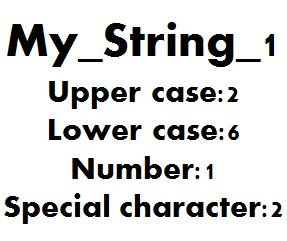Python code to Count Uppercase, Lowercase,Special character and Numeric values
Python code to Count Uppercase, Lowercase, Special character and Numeric values
In this article, we will discuss the concept of the Python code to Count Uppercase, Lowercase, Special character and Numeric values
In this post, we are going to learn how to count the total number of Uppercase, Lowercase, Special character and Numeric values of the given String in Python programming language


Python code to Count Uppercase, Lowercase, Special character and Numeric values using for loop
The program allows the user to enter a String and then it counts and display the total number of upper case, lower case, numeric values and special characters of the given string using for loop in Python programing language
Program 1
#Python code to Count Uppercase, Lowercase, Special character and Numeric values
str=input("Please enter a string: ")#take input from the user
upper, lower, num, special=0,0,0,0;#variable declaration and initilization
for i in range(len(str)):
if(str[i]>='A' and str[i]<='Z'):#check upper case letters
upper+=1
elif(str[i]>='a' and str[i]<='z'):#check lower case letter
lower+=1
elif(str[i]>='1' and str[i]<='9'):#check numeric value
num+=1
else:
special+=1
print("Upper case letters: ",upper)
print("\nLower case letters: ",lower)
print("\nnumbers: ",num)
print("\nSpecial characters: ",special)
When the above code is executed, it produces the following result
Please enter a string: CodeForCoding:code4coding.com Upper case letters: 3 Lower case letters: 23 numbers: 1 Special characters: 2
Approach
- Declare a String variable as str;
- Declare and initialize integer variables as int upper, lower, num, Special=0,0,0,0;
- The user asked to enter a string to count upper case, lower case, Numeric, Special characters
- The given string is stored in the variable str;
- A for-loop is used to count total characters of the given string.
- Use an if condition to test if(str[i]>=’A’ and str[i]<=’Z’). If it is true, The upper becomes upper + 1(upper=upper+1);
- When it is false, control moves to the elif part and evaluates the test-expression of elif. if it is true The lower becomes lower + 1(lower=lower+1
- When it is false, control moves to the next elif part and evaluates the test-expression of elif. if it is true The num becomes num+1(num=num+1);
- When it is false, control moves to the else part and executes the else part statements. the special becomes special+1
- Finally, the program displays the total number of the upper case, lower case, Numeric, Special characters of the given string
Python code to Count Uppercase, Lowercase, Special character and Numeric values using the built-in function
The program allows the user to enter a String and then it counts and display the total number of upper case, lower case, numeric values and special characters of the given string using the built-in function in Python programing language
Program 2
#Python code to Count Uppercase, Lowercase, Special character and Numeric values
str=input("Please enter a string: ")
upper, lower, num, special=0,0,0,0;
for i in range(len(str)):
if(str[i].isupper()):
upper+=1
elif(str[i].islower()):
lower+=1
elif(str[i].isdigit()):
num+=1
else:
special+=1
print("Upper case letters: ",upper)
print("\nLower case letters: ",lower)
print("\nnumbers: ",num)
print("\nSpecial characters: ",special) When the above code is executed, it produces the following result
Please enter a string: MuCode:code4coding.com Upper case letters: 2 Lower case letters: 17 numbers: 1 Special characters: 2
Suggested for you
Similar post
C++ code to count the total number of characters in the given string
C code to count the total number of characters in the given string
Python code to count the total number of characters in the given string
Java program to count the total number of characters in the given string including space
C program to count the total number of characters in the given string including space
C++ program to count the total number of characters in the given string including space
Recent Posts
10 best Ways to Subtract Two Numbers in Java (With Examples)
10 best Ways to Subtract Two Numbers in Java (With Examples) In this article, we…
Array Data Structure: Definition, Types, Operations & Advantages
Array Data Structure: Definition, Types, Operations & Advantages Array Data Structure Introduction In this post,…
20 ways to subtract two numbers in Java
20 ways to subtract two numbers in Java In this article, we will discuss the…
10 simple ways to add two numbers in Java
10 simple ways to add two numbers in Java In this article, we will discuss…
Write a Python program to find the first n prime numbers
Write a Python program to find the first n prime numbers In this article we…
Python: Calculate Average of odd and even in a list using loops
Python: Calculate Average of odd and even in a list using loops In this post,…